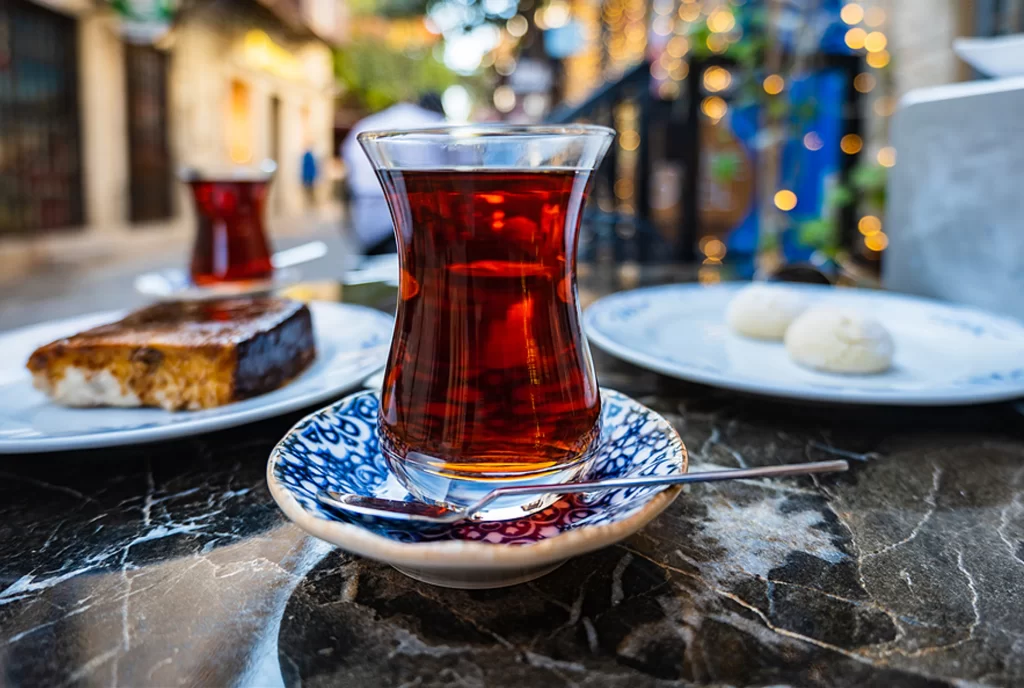
Turkish tea isn’t just a drink. It’s an experience. An intricate process of making, imbibing, sharing. The essence of Turkish hospitality and culture. Wherever you are, a sip transports you to its roots.
Turkish Cuisine Revealed: A Story of Taste and Tradition!
Finding the Perfect Leaves
Choosing the right tea leaves is crucial. Loose-leaf black tea is favored. Each leaf must be whole, aromatic. This isn’t casual; it’s deliberate. Every small, crinkled leaf promises depth, richness, a hint of the regions they hail from. A journey in each sip.
Setting Up the Çaydanlık
The çaydanlık, a double teapot, stands ready. Bottom pot, filled with water, starts to boil. Top pot holds the precious leaves. Leaves steam gently, flavors unfurl slowly. This dual system isn’t mere convenience. It’s tradition, perfected.
The Steeping Alchemy
Boiling water isn’t simply poured over leaves. No, there’s finesse in the act. A little is added to the top pot, coaxing the leaves to release their essence. The rest stays simmering below, awaiting its moment.
The Dance of Concentration
The result, a concentrated brew, strong and potent. It’s not meant to be drunk straight. Instead, it’s mixed with hot water from the bottom pot. Personalized, each cup carries an individual’s touch. A blend of intensity and warmth.
Glasses That Tell Stories
Small tulip-shaped glasses serve tea. Not just for aesthetics. They let the amber glow of tea shine through. Each glass, a promise of the rich experience that follows. Holding one feels both delicate and powerful.
Ritual of Serving
Serving tea is a dance of tradition. A gesture of welcome, community. Hosts pour meticulously, balancing concentrate and water. Guests receive not just tea but a token of goodwill. It’s an unspoken language, rich in history.
Sweet Companions
Baklava, Turkish delight, simit often accompany tea. They’re not random choices. Each sweet enhances tea’s flavor, provides a counterpoint. It’s a harmony of tastes, experiences.
Conversations Over Tea
Tea fosters conversations. A bonding agent, bringing people together. In homes, offices, tea houses, people gather over tea. They share stories, laughter, silences. Tea is central, a catalyst.
Generational Gift
Tea culture passes through generations. Grandparents teach grandchildren the rituals, the subtleties. Each generation imbues it with new facet, yet respects tradition. It’s a living heritage.
Regional Nuances
Regions, each with its tea style. Eastern tea might be robust, intense. Urban centers favor balanced brews. Across distances—from Istanbul to Dubai—rituals adapt. Yet, the core remains untouched.

Meditative Preparation
Making tea can feel meditative. Each step requires attention, care. Boiling, steeping, mixing—it’s deliberate. A pause in life’s rush. Calming, grounding.
Slow Moments
Tea invites slowness. Savoring, not rushing. Each taste is examined, appreciated. It’s more than nourishment. It’s reflection, connection.
Tradition and Evolution
While deeply traditional, Turkish tea evolves. Modern twists don’t discard the past. They honor it, blend it with the new. A dynamic tradition, always growing.
Cultural Linchpin
Turkish tea goes beyond drink. It’s culture, history, connection. Each cup ties past to present. Methodical preparation, serving ritual, shared enjoyment—it’s all interwoven. Turkish tea, a tapestry of experiences, sensations.
Synthesis of Elements
The tea’s aroma hits first. A promise. The first sip, strong yet inviting. The warmth spreads, soothing. You’re in the moment, across time. Past, present, future—all there in the cup.
Ongoing story
Turkish tea, an artifact of culture, not merely a beverage. Its journey from leaves to cup is meticulous, cherished. With each preparation, a tradition re-lived. An anchor in the swirling rapids of modern life. Each interaction over tea, a chapter in an ongoing story.
